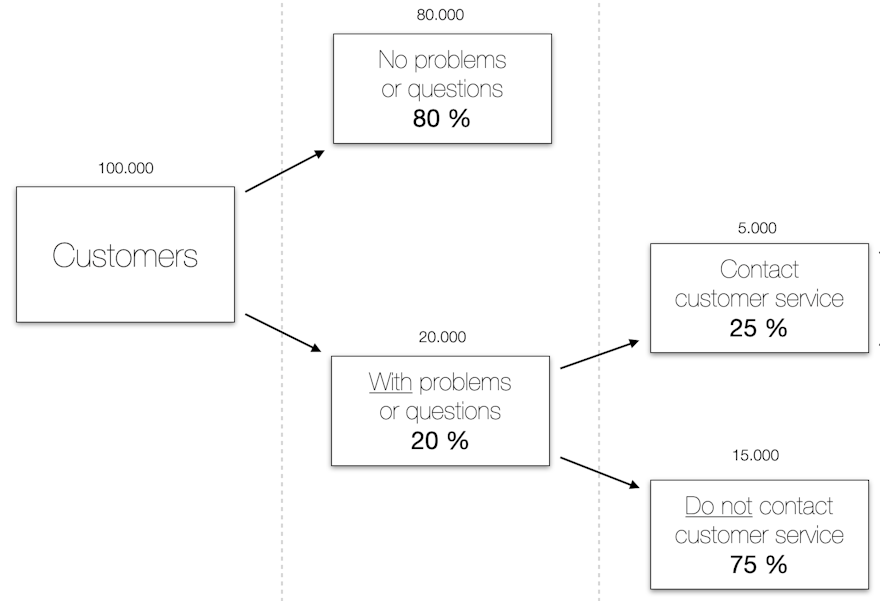Actions to mitigate those risks
By gaining more insight into what customers are asking, combining that with customer service automation and encouraging customers to come forward, an incredible continuous revenue improvement cycle can be set up.
Action 1 - gaining insights
Knowledge is power
Before we change anything, the first step is to understand why customers are contacting us.
The goal is to know the why such that structural adjustments to the process or product can be made that caused the question. This will avoid such questions in the future.
Most companies today have some notion of this:
- 13% questions on billing
- 21% product questions
- 6% sales quotes
- ...
- 54% other / general
Does that sound familiar? These are typically the contact reason drop-downs in CRM systems that have somewhere between five and several hundreds of options service agents need to chose from. The agents are notoriously falling back on the 'other / general' reason which is overrepresented.
The problem with these contact reasons is that they are too high-level and prone to service agent error. Instead, what we want are contact reasons at a very granular level.
This is where Orion comes in. Orion will automatically determine the detailed primary contact reason for each question. These will be aggregated such that those insights are continuously available. This looks like this:
- month October:
4.5% billing | information on invoice unclear - month October:
2.8% billing | dispute of charges on invoice - ...
- month October:
7.1% selfservice | selfservice raised error when changing delivery address - month October:
6.7% sales | questions regarding the warranty period of product ABC - ...
Benefit of detailed insights
With this detail in hand, the customer service department is empowered to raise the issue with other departments. Together, they can prioritise which structural fix to apply first according to question volume and the value for the company. A continuous company-wide improvement process can now take form, resulting in less customer questions and increased revenue.
Action 2 - automation
Applying targeted answer automation and deflection
Now we have insight into why customers are reaching out, we must be realistic and acknowledge that:
- Not all structural fixes can be applied immediately because company resources for such projects are limited in time.
- Some question volume will always remain even though measures have been taken.
In order to deal with that, make sure to answer as efficient as possible on the questions flowing in. Since Orion is able to identify the contact reasons, this is an ideal candidate to apply automated answering and deflection:
- Automated answering: Orion has recognised the contact reason with great certainty and will answer the customer with a predefined answer (this can include customer specific information such as delivery address, delivery time, ... or other information retrieved from the ERP system). It is crucial that you answer as specific as possible as it will avoid additional follow-up questions by the customer.
- Deflection: Orion is fairly certain regarding the contact reasons or has detected multiple contact reasons. Orion sends a limited set of self-help articles to the customer. The customer can always indicate to transfer the question to a human service agent.
Action 3 - open the gates
Getting those silent customers with problems to reach out to customer service
Everything is now in place for our final action: we will now attempt to increase the percentage of customers with problems that are not reaching out.
Otherwise put: we want as much customers as possible to communicate their issues to us.
Does that sound crazy? We are aware that traditionally customer service has always been viewed as a cost-incurring, not generating any revenue. As a consequence it often happens that customer service is making it purposefully difficult for the customer to reach out (hiding email addresses and contact forms, burying telephone numbers deep in the general terms,...).
Although such strategies reduce customer service cost in the short-term, they are detrimental to revenue in the long-term. As illustrated above, the vast majority of customers at risk (churn) is within the population of customers with issues that are not reaching out. When customers are enabled to contact you, issues become visible and solvable. Churn decreases and revenue goes up.
We are deliberately taking actions in this order. If you are to open the gates immediately, you risk flooding your service agents. Instead, when you have fixed your number one process/product issues and you have (some) automation in place, then you are ready to open the gates.
Want to know what the results are? Check our next blog post!


